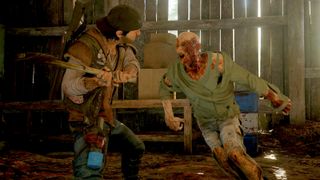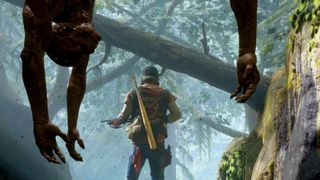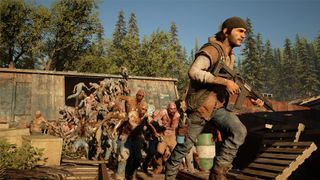Fast zombies. Slow zombies. Cursed zombies. Virus-infected zombies. It’s safe to say we’re all used to walking corpses by now. Featuring them in a game in an entirely new way is becoming increasingly difficult. Left 4 Dead gives us the Infected who absolutely sprint towards us, The Last of Us has the feral fungus zombies, and Resident Evil is home to the grossly-mutated T-Virus victims. It seems like all the bases are covered. And they probably are. Yet Days Gone has decided to not focus on how their zombies look or were created, but how they behave as part of their very own undead ecosystem.

Us humans are at the top of the food chain. Except, that is, in the world of Days Gone, where most of the human race has been infected by an unknown virus and turned into feral, flesh-hungry zombies - sorry, Freakers - with razor-sharp hearing. But we’re not the only ones affected by the viral outbreak. Whether it’s an airborne virus or some sort of curse, it’s relatively rare to see zombie apocalypses that have affected animals. There are some examples where reanimated animals have reared their not-so-furry heads, such as Resident Evil’s famous zombie Dobermans (plus who can forget the zombie elephant in Resident Evil Outbreak: File #2?). Days Gone is bucking that trend, and is welcoming zombie mammals with open, slightly-decaying arms.
Breaking the mould
Because of course the virus hasn’t just affected humans. It’s somehow spread to animals too, including the grizzly bear (now Rager Bear), and wolves (called Runners as they can outrun Deacon’s bike). What does all this mean? In short, Bend Studio has created an ecosystem. Consisting of various ‘interacting organisms’ - yeah, that’s right, I looked up the definition - this ecosystem is a blend of animal and human zombies, each with a defined role to play. Relieving human Freakers from following the same structure as say, Left 4 Dead, this small tweak allows Bend Studio to emphasise their behavioural quirks rather than physical ones. You see, the stumbling, lurching infected in Valve’s multiplayer masterpiece occupy various strategic roles and are physically defined by them. The rotund Boomer distracts the survivors with its horde-attracting bile attack, the Smoker breaks up the group by dragging one away using a grossly long tongue, and the bulky Tank (and the emaciated Witch, to a lesser degree) are boss encounters. In Days Gone some of these roles are delegated to animals. Runners act as disruptors while Rager Bears are mini boss encounters. Freakers are kept relatively simple. There are newts (adolescent freakers who have a penchant for ambushing), swarms, and hordes, but by the looks of it there’s not the array of zombie archetypes we’re used to seeing in Dead Island, Dead Rising, Resident Evil, or Dying Light.

Ordinarily this might make it look like the Freakers are simpler. In a way they are, and in another way they most certainly are not. Sure, they’re in the same vein of infected humans we know from Left 4 Dead and Resident Evil. They all look mostly similar with the usual array of ripped clothing and blistering sores. But they have rules. And what’s more, the survivors in Days Gone understand these rules and have built their lives around manipulating them. Gnashing their teeth and emitting various whoops and growls, the Freakers are tenacious. They’re attracted to meat (even if it’s dead), so the ‘meat wall’ that borders the scavenger camp is to distract any ambling Freakers that wander their way. They’re stronger when it’s cold, which isn’t determined by different levels of the game but rather depends on Days Gone’s dynamic weather system, which will alter randomly to vary your encounters. Most obviously, they are incredibly sensitive to sound.
Exploiting the end of the world
Us humans are part of this ecosystem too. Deacon and his fellow survivors (both good and bad) don’t just kill Freakers - they manipulate them. Freakers have become so synonymous with the world of Days Gone (well, with what’s left of it) and humans have become to used to them that a chunk of the fear has gone, being replaced by the knowledge that these emaciated infected are a weaponizable force. Hung upside down from trees to catch anyone who walks by, or attracted by the sound of an explosion to gnaw on the massive group of bandits you couldn’t handle alone, Freakers are far from being solely an enemy. They have the same moral indifference as wild animals, with their lack of intelligence an odd kind of benefit for you.
Even when they start to run after any humans who mistakenly enter their line of sight, they have rules. Taking the quickest possible route to grab those tasty fleshy bodies, they don’t really take the time to stop and consider strategy. Which bandits and survivors know very well, building their camp on stilts because the Freakers can’t climb particularly well. Especially if there are humans below to distract them. The way NPCs have built their lives around manipulating Freakers (and avoiding their animal friends), around interacting with these different undead not only to avoid their bite but also to use them tactically, is astounding. And that’s all thanks to this carefully-crafted ecosystem that’s as deadly as it is exploitable. Days Gone is sure to get hearts racing, just remember - if you use them right, the Freakers are your friends.



